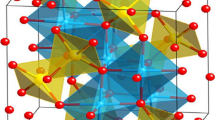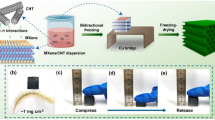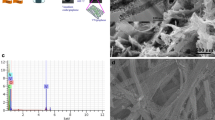Abstract
Successful exploration of supercapacitor (SC) material to integrate with high energy and high power density storage device still remains a daunting challenge. Conducting carbon nanostructures have been primarily used for this purpose; however, most of their surface area remains unutilized throughout the storage process. Herein, a new type of hybrid material has been reported by effectively using active sides of carbon nanostructures. Insertion of faradaic-type polyoxometalates (POMs), namely phosphotetradecavanadate (Na7[H2PV14O42], hereafter described as PV14), into the graphene oxide (GO) matrix creates a novel hybrid material for SC applications. Owing to the formation of nanohybrid, it can store charges both electrostatically and electrochemically. PV14/GO composite’s electrochemical behavior in different electrolyte (acidic/neutral) solutions shows different types of characteristics. The PV14/GO composite as a working electrode exhibits a high galvanostatic capacitance of 139 F/g while maintaining at a power density of 97.94 W/kg in 0.25 M H2SO4 electrolyte. The specific energy density was also found out to be around 56.58 Wh/kg at a 5 mV/s scan rate for the same electrolyte. Furthermore, in 1 M Na2SO4 solution, PV14/GO composite demonstrates a specific capacitance of 85.4 F/g at a scan rate of 5 mV/s. The equivalent series resistance for the device was found to be approximately 0.51 Ω with a circuit resistance of 3.881 Ω, using electrochemical impedance spectroscopy. The cell capacitance, employing the Nyquist plot, was calculated to be around 2.78 mF.






Similar content being viewed by others
References
L. Dong, C. Xu, Y. Li, Z.H. Huang, F. Kang, Q.H. Yang, and X. Zhaow, Flexible Electrodes and Supercapacitors for Wearable Energy Storage: A Review by Category, J. Mater. Chem. A, 2016, 4(13), p 4659–4685
Y. Zhu, S. Murali, M.D. Stoller, K.J. Ganesh, W. Cai, P.J. Ferreira, A. Pirkle, R.M. Wallace, K.A. Cychosz, M. Thommes, and D. Su, Carbon-Based Supercapacitors Produced by Activation of Graphene, Science, 2011, 332(6037), p 1537–1541
P. Simon, and Y. Gogotsi, Materials for Electrochemical Capacitors, in Nanoscience and Technology: A Collection of Reviews from Nature Journals, 2010, p 320-329.
K. Zhang, X. Han, Z. Hu, X. Zhang, Z. Tao, and J. Chen, Nanostructured Mn-Based Oxides for Electrochemical Energy Storage and Conversion, Chem. Soc. Rev., 2015, 44(3), p 699–728
J. Vatamanu, Z. Hu, D. Bedrov, C. Perez, and Y. Gogotsi, Increasing Energy Storage in Electrochemical Capacitors with Ionic Liquid Electrolytes and Nanostructured Carbon Electrodes, J. Phys. Chem. Lett., 2013, 4(17), p 2829–2837
G.Z. Chen, Understanding Supercapacitors Based on Nano-hybrid Materials with Interfacial Conjugation, Progr. Nat. Sci.: Mater. Int., 2013, 23(3), p 245–255
W. Li, F. Zhang, Y. Dou, Z. Wu, H. Liu, X. Qian, D. Gu, Y. Xia, B. Tu, and D. Zhao, A Self-Template Strategy for the Synthesis of Mesoporous Carbon Nanofibers as Advanced Supercapacitor Electrodes, Adv. Energy Mater., 2011, 1(3), p 382–386
C.H.A. Wong, A. Ambrosi, and M. Pumera, Thermally Reduced Graphenes Exhibiting a Close Relationship to Amorphous Carbon, Nanoscale, 2012, 4(16), p 4972–4977
E. Raymundo-Piñero, F. Leroux, and F. Béguin, A High-Performance Carbon for Supercapacitors Obtained by Carbonization of a Seaweed Biopolymer, Adv. Mater., 2006, 18(14), p 1877–1882
C. Liu, Z. Yu, D. Neff, A. Zhamu, and B.Z. Jang, Graphene-Based Supercapacitor with an Ultrahigh Energy Density, Nano Lett., 2010, 10(12), p 4863–4868
Y. Shao, M.F. El-Kady, L.J. Wang, Q. Zhang, Y. Li, H. Wang, M.F. Mousavi, and R.B. Kaner, Graphene-Based Materials for Flexible Supercapacitors, Chem. Soc. Rev., 2015, 44(11), p 3639–3665
B. Xu, S. Yue, Z. Sui, X. Zhang, S. Hou, G. Cao, and Y. Yang, What is the Choice for Supercapacitors: Graphene or Graphene Oxide?, Energy Environ. Sci., 2011, 4(8), p 2826–2830
Q. Zhang, K. Scrafford, M. Li, Z. Cao, Z. Xia, P.M. Ajayan, and B. Wei, Anomalous Capacitive Behaviors of Graphene Oxide Based Solid-State Supercapacitors, Nano Lett., 2014, 14(4), p 1938–1943
R.B. Rakhi and M.L. Lekshmi, Reduced Graphene Oxide Based Ternary Nanocomposite Cathodes for High-Performance Aqueous Asymmetric Supercapacitor, Electrochim. Acta, 2017, 231, p 539–548
S. Wang, N. Liu, J. Su, L. Li, F. Long, Z. Zou, X. Jiang, and Y. Gao, Highly Stretchable and Self-Healable Supercapacitor with Reduced Graphene Oxide Based Fiber Springs, ACS Nano, 2017, 11(2), p 2066–2074
X. Xiao, T. Li, Z. Peng, H. Jin, Q. Zhong, Q. Hu, B. Yao, Q. Luo, C. Zhang, L. Gong, and J. Chen, Freestanding Functionalized Carbon Nanotube-Based Electrode for Solid-State Asymmetric Supercapacitors, Nano Energy, 2014, 6, p 1–9
Q. Zhang, C. Cai, J. Qin, and B. Wei, Tunable Self-Discharge Process of Carbon Nanotube Based Supercapacitors, Nano Energy, 2014, 4, p 14–22
P.C. Chen, G. Shen, Y. Shi, H. Chen, and C. Zhou, Preparation and Characterization of Flexible Asymmetric Supercapacitors Based on Transition-Metal-Oxide Nanowire/Single-Walled Carbon Nanotube Hybrid Thin-Film Electrodes, ACS Nano, 2010, 4(8), p 4403–4411
K. Leitner, A. Lerf, M. Winter, J.O. Besenhard, S. Villar-Rodil, F. Suarez-Garcia, A. Martinez-Alonso, and J.M.D. Tascon, Nomex-Derived Activated Carbon Fibers as Electrode Materials in Carbon Based Supercapacitors, J. Power Sources, 2006, 153(2), p 419–423
Y. Huang, Y. Zhao, Q. Gong, M. Weng, J. Bai, X. Liu, Y. Jiang, J. Wang, D. Wang, Y. Shao, and M. Zhao, Experimental and Correlative Analyses of the Ageing Mechanism of Activated Carbon Based Supercapacitor, Electrochim. Acta, 2017, 228, p 214–225
H. Xia, Y.S. Meng, G. Yuan, C. Cui, and L. Lu, A Symmetric RuO2/RuO2 Supercapacitor Operating at 1.6 V by Using a Neutral Aqueous Electrolyte, Electrochem. Solid State Lett., 2012, 15(4), p A60
O. Ghodbane, J.L. Pascal, and F. Favier, Microstructural Effects on Charge-Storage Properties in MnO2-Based Electrochemical Supercapacitors, ACS Appl. Mater. Interfaces, 2009, 1(5), p 1130–1139
M. Sadakane and E. Steckhan, Electrochemical Properties of Polyoxometalates as Electrocatalysts, Chem. Rev., 1998, 98(1), p 219–238
J. Hu, Y. Ji, W. Chen, C. Streb, and Y.F. Song, “Wiring” Redox-Active Polyoxometalates to Carbon Nanotubes Using a Sonication-Driven Periodic Functionalization Strategy, Energy Environ. Sci., 2016, 9(3), p 1095–1101
S. Kumari, S. Maity, A.A. Vannathan, D. Shee, P.P. Das, and S. Mal, Improved Electrochemical Performance of Graphene Oxide Supported Vanadomanganate (IV) Nanohybrid Electrode Material for Supercapacitors, Ceram. Int., 2020, 46(3), p 3028–3035
E. Ni, S. Uematsu, Z. Quan, and N. Sonoyama, Improved Electrochemical Property of Nanoparticle Polyoxovanadate K7NiV13O38 as Cathode Material for Lithium Battery, J. Nanopart. Res., 2013, 15(6), p 1732
A. Afif, S.M. Rahman, A.T. Azad, J. Zaini, M.A. Islan, and A.K. Azad, Advanced Materials and Technologies for Hybrid Supercapacitors for Energy Storage—A Review, J. Energy Storage, 2019, 25, p 100852
S. Najib and E. Erdem, Current Progress Achieved in Novel Materials for Supercapacitor Electrodes: Mini Review, Nanoscale Adv., 2019, 1(8), p 2817–2827
A.K. Cuentas-Gallegos, R. Martínez-Rosales, M. Baibarac, P. Gomez-Romero, and M.E. Rincón, Electrochemical Supercapacitors Based on Novel Hybrid Materials Made of Carbon Nanotubes and Polyoxometalates, Electrochem. Commun., 2007, 9(8), p 2088–2092
J.J. Chen, M.D. Symes, S.C. Fan, M.S. Zheng, H.N. Miras, Q.F. Dong, and L. Cronin, High-Performance Polyoxometalate-Based Cathode Materials for Rechargeable Lithium-Ion Batteries, Adv. Mater., 2015, 27(31), p 4649–4654
X. Sang, X. Xu, L. Bian, X. Liu, and Y. Wang, The Loading of Polyoxometalates Based Compound on Reduced Graphene Oxide, a Composite Material for Electrical Energy Storage and Tetracycline Removal, Solid State Sci., 2018, 83, p 8–16
C.C. Lin, W.H. Lin, S.C. Huang, C.W. Hu, T.Y. Chen, C.T. Hsu, H. Yang, A. Haider, Z. Lin, U. Kortz, and U. Stimming, Mechanism of Sodium Ion Storage in Na7 [H2PV14O42] Anode for Sodium-Ion Batteries, Adv. Mater. Interfaces, 2018, 5(15), p 1800491
D.C. Marcano, D.V. Kosynkin, J.M. Berlin, A. Sinitskii, Z. Sun, A. Slesarev, L.B. Alemany, W. Lu, and J.M. Tour, Improved Synthesis of Graphene Oxide, ACS Nano, 2010, 4(8), p 4806–4814
S. Jana, N. Singh, A.S. Bhattacharyya, and G.P. Singh, Synthesis of Self-Assembled rGO-Co3O4 Nanoparticles in Nanorods Structure for Supercapacitor Application, J. Mater. Eng. Perform., 2018, 27(6), p 2741–2746
T. Liu, L. Li, L. Zhang, B. Cheng, W. You, and J. Yu, 0D/2D (Fe0. 5Ni0. 5) S2/rGO Nanocomposite with Enhanced Supercapacitor and Lithium Ion Battery Performance, J. Power Sources, 2019, 426, p 266–274
H.Y. Chen, G. Wee, R. Al-Oweini, J. Friedl, K.S. Tan, Y. Wang, C.L. Wong, U. Kortz, U. Stimming, and M. Srinivasan, A Polyoxovanadate as an Advanced Electrode Material for Supercapacitors, ChemPhysChem, 2014, 15, p 2162–2169
Acknowledgments
This work was fully supported by the Council of Scientific and Industrial Research (CSIR), New Delhi, India, under scheme 01/(/(2906)/17/EMR-II. S.M. and A.A.V. thank the National Institute of Technology Karnataka for financial assistance to carry out the research.
Author information
Authors and Affiliations
Corresponding authors
Additional information
Publisher's Note
Springer Nature remains neutral with regard to jurisdictional claims in published maps and institutional affiliations.
Electronic supplementary material
Below is the link to the electronic supplementary material.
Rights and permissions
About this article
Cite this article
Maity, S., Vannathan, A.A., Kumar, K. et al. Enhanced Power Density of Graphene Oxide–Phosphotetradecavanadate Nanohybrid for Supercapacitor Electrode. J. of Materi Eng and Perform 30, 1371–1377 (2021). https://doi.org/10.1007/s11665-020-05349-w
Received:
Revised:
Accepted:
Published:
Issue Date:
DOI: https://doi.org/10.1007/s11665-020-05349-w




